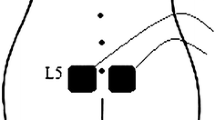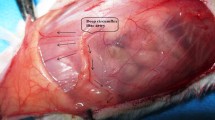Abstract
Transcutaneous electrical nerve stimulation (TENS) is primarily used for pain reduction and is thought to activate neural fibers modifying vascular resistance and local blood flow influencing flap necrosis. This study aimed to delineate the effects of TENS on the viability of skin flaps created during mastectomy in breast cancer patients. Patients treated with modified radical mastectomy were prospectively randomized to receive either TENS or no further local treatment postoperatively. High frequency (70 Hz) and low intensity (2 mA) TENS was applied and areas of flap ecchymosis and necrosis were measured after the completion of TENS application and compared between the two groups. Patients were also compared according to age, comorbid diseases, duration of anesthesia, flap area, amount of wound drainage and seroma, presence of wound infection and abscess. In addition, local and systemic complications related to TENS were recorded. About 173 patients with a median age of 49 (range 25–87) were included in the study. About 87 patients received TENS whereas 86 patients formed the control group. Patients’ characteristics were comparable between the two groups. Number of patients with skin flap necrosis was higher in the control group compared to TENS group (P < 0.0001). Mean area of flap necrosis was significantly lower in TENS group (85.2 ± 35.9) compared to control group (252.5 ± 64.1; P = 0.024). Similarly, number of patients with skin flap ecchymosis was higher in the control group compared to TENS group (P = 0.002). However, although mean area of flap ecchymosis was lower in TENS group (105.5 ± 49.8) compared to control group (172.9 ± 49.9), this difference did not reach statistical significance (P = 0.34). In addition, there were no local or systemic complications related to TENS application in patients. TENS can be safely used to decrease the amount of skin flap necrosis after mastectomy in breast cancer patients without any additional complication.
Similar content being viewed by others
References
Kjartansson J, Lundeberg T, Körlof B (1988) Transcutaneous electrical nerve stimulation (TENS) in ischemic tissue. Plast Reconstr Surg 81:813–815
Lundeberg T, Kjartansson J, Samuelsson U (1988) Effect of electrical nerve stimulation on healing of ischemic skin flaps. Lancet 24:712–714. doi:10.1016/S0140-6736(88)90187-0
Kjartansson J, Lundeberg T (1990) Effects of electrical nerve stimulation (ENS) in ischemic tissue. Scand J Plast Reconstr Hand Surg 24:129–134. doi:10.3109/02844319009004532
Atalay C, Kockaya EA, Cetin B, Kismet K, Akay MT (2003) Efficacy of topical nitroglycerin and transcutaneous electrical nerve stimulation on survival of random-pattern skin flaps in rats. Scand J Plast Reconstr Surg Hand Surg 37:10–13. doi:10.1080/713796082
Liebano RE, Abla LEP, Ferreira LM (2008) Effect of low-frequency transcutaneous electrical nerve stimulation (TENS) on the viability of ischemic skin flaps in the rat: an amplitude study. Wound Rep Reg 16:65–69. doi:10.1111/j.1524-475X.2007.00332.x
Chen JQ, Yonehara N, Imai Y, Xu WJ, Inoki R (1991) Effects of morphine on cutaneous blood flow and substance P release evoked by electrical stimulation on rat sciatic nerve. Acta Pharmacol Sin 12:355–357
Kjartansson J, Lundeberg T, Samuelsson UE, Dalsgaard J, Heden P (1988) Calcitonin gene-related peptide (CGRP) and transcutaneous electrical nerve stimulation (TENS) increase cutaneous blood flow in a musculocutaneous flap in the rat. Acta Physiol Scand 134:89–94. doi:10.1111/j.1748-1716.1988.tb08463.x
Linderoth B, Gunasekera L, Meyerson BA (1991) Effects of sympathectomy on skin and muscle microcirculation during dorsal column stimulation: animal studies. Neurosurgery 29:874–879. doi:10.1097/00006123-199112000-00012
Tracy JE, Currier DP, Threlkeld AJ (1988) Comparison of selected pulse frequencies from two different electrical stimulators on blood flow in healthy subjects. Phys Ther 68:1526–1532
Jenbeck J, Daslgaard CJ (1993) Calcitonin gene-related peptide treatment of flaps with compromised circulation in humans. Plast Reconstr Surg 91:236–244
Fan Z, He J (1993) Preventing necrosis of the skin flaps with nitroglycerin after radical resection for breast cancer. J Surg Oncol 53:210. doi:10.1002/jso.2930530319
Author information
Authors and Affiliations
Corresponding author
Rights and permissions
About this article
Cite this article
Atalay, C., Yilmaz, K.B. The effect of transcutaneous electrical nerve stimulation on postmastectomy skin flap necrosis. Breast Cancer Res Treat 117, 611–614 (2009). https://doi.org/10.1007/s10549-009-0335-z
Received:
Accepted:
Published:
Issue Date:
DOI: https://doi.org/10.1007/s10549-009-0335-z




